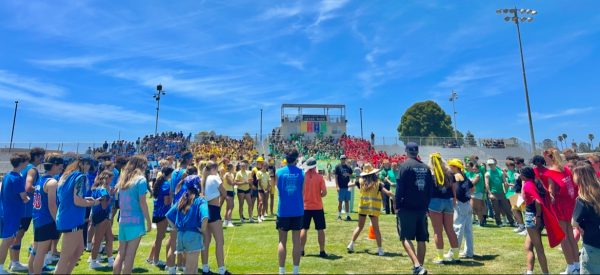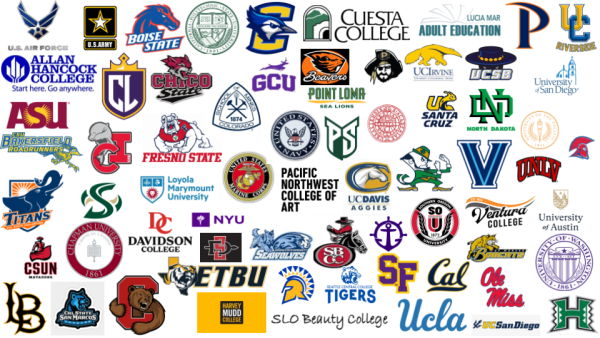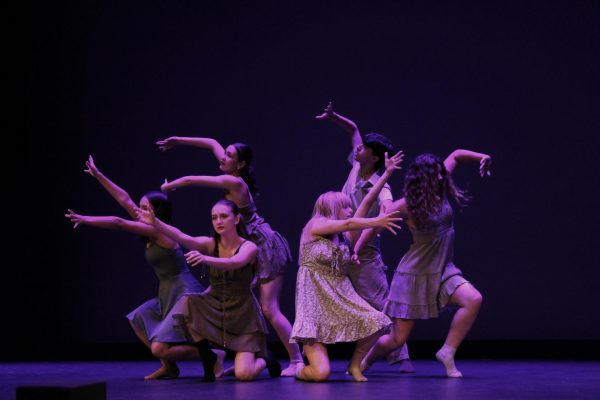Today’s cheerleaders: too much focus on leading, not enough on cheering
AGHS cheerleaders performing for the crowd at the AG vs Pioneer Valley football game
In June of 2021, the Supreme Court ruled in favor of a Pennsylvania cheerleader, declaring that her use of the F-word in a social media post was within her rights of free speech and non-disruptive to other students. Before this resolution, the cheerleader had been suspended from the team for the post, with the school claiming her use of such language was disruptive to the learning environment.
In regards to the case, Justice Stephen Breyer said that the language used by the teenager “is the kind of pure speech to which, if she were an adult, the First Amendment would provide strong protection.”
An AGHS cheerleader, Jessica McNeill (‘23), faced a similar issue during the 2021 cheer season. She posted a series of photos on her private Instagram account, one of which showed her holding her middle finger to the camera.
“My mental health went down so much because I was constantly worried that somebody was going to get me in trouble with school and the coaches… and it was never bad,” McNeill said. “No smoking, no drinking… [but my middle finger was] like the biggest deal ever.”
McNeill faced pressure and threats from her teammates and coaches over the post, something determined to be within her constitutional rights, same as Pennsylvania’s previous case. In fact, the type of post created by McNeill and other similar social media posts that generate scorn for cheerleaders are less provocative than the post in the supreme court case. In this case, the cheerleader posted messages targeting the school and the cheerleading program with her profanity. In local instances where cheerleaders face the same consequences for their social media posts and image, the posts are most often not directed towards the school, athletic administration, or any person in particular.
Cheerleaders across the United States at high school, collegiate, and professional levels face discrimination and judgment based on appearance and harassment.
In Kenosha, Wisconsin, in 2018, a school district and cheerleading program faced backlash for the type of awards presented at an end-of-the-season banquet. Some of the awards handed out were the “Big Boobie” (for largest breasts), the “Big Booty” (biggest butt), and the “String Bean” (thinnest cheerleader). Parents and players were horrified at the objectification of minors by someone supposed to be a respected figure.
A professional cheerleader for the NFL team the New Orleans Saints was fired in January of 2018 for posting a photo of herself in a bodysuit on her private Instagram account. In an interview with NPR, she stated that “if I post something, and I’m in a swimsuit or in a body suit, it’s seen as something sexual, but the players can post shirtless in their underwear and be seen as athletic.”
This double standard aligns with the complaints of McNeill and her teammate, Taylor Dungan (‘23).
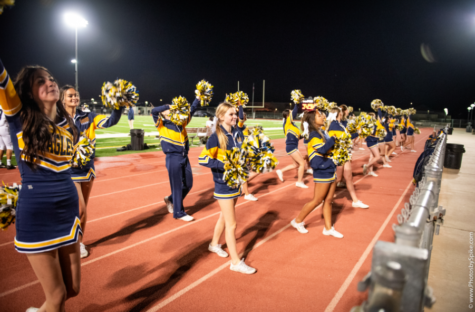
“It’s also… ironic how they put us in these… very tiny uniforms, and we’re basically there to be sexualized and cheer on the football team,” Dungan said.
McNeill explained how the cheerleading squad was unable to perform their halftime show at one point due to complaints about the language usage in their performance song.
“One time [those who made the complaint] said that we couldn’t use a halftime song because it said ‘hell’ in it,” McNeill said. “But then, you know, you hear the football boys on the sideline screaming so much worse.”
“I was getting in trouble for stuff on my Instagram a while ago… and compared to what the football players are posting and commenting on other people’s posts, it’s kind of just like… why?” McNeill added.
Dungan chimed in with her confusion over the difference in expectations for football players and cheerleaders.
“It’s a little confusing to me, actually,” she said. “We can’t post anything ‘bad’ on our Instagram or social media, because… we represent the school spirit, but when I think about high school sports, I think about football… it’s a little contradicting.”
Both McNeill and Dungan expressed distaste for the fact that cheerleaders are expected to follow lengthy and strict guidelines, while football players receive little to no reprimand for similar rules and issues.
Instead of having a sort of set contract or signed list of rules, current AGHS football coach, Michael Hartman, noted that he “currently just define[s] the expectations for the football players verbally.”
The double standard for cheerleaders and football players exists beyond the NFL, apparent in the high school sports programs of San Luis Obispo county as well. The cheerleaders of Paso Robles High School have to adhere to a twelve-page contract with strict and detailed rules. There is a full section dedicated to tardies and absences from practice, restrictions on clothing allowed to be worn at practices and at school, makeup, hair, piercings, and nails. Off-campus and on-campus behavior is covered by the contract, including social media, claiming that pictures posted on the internet “should be age appropriate,” a subjective criterion. In sharp contrast, the football players of Paso Robles High School have a list of ten simple rules on the football website, such as “do not lie, do not cheat, do not steal,” with the final rule simply listing “Beat Arroyo Grande.”
Templeton High School has similar rules for their cheerleaders, some as strict as “undergarments or excess skin must not be shown while in uniform.” In Templeton’s cheer contract, there is a section dedicated wholly to cheerleaders’ attitudes.
In the cheer contract specific to AGHS, cheerleaders are expected to abide by absolute yet fairly general terms such as: “inappropriate behavior on social media is… unacceptable.”
“Unnatural hair color and excessive jewelry is not permitted while in uniform.”
“I think… the school cares more about the cheerleaders’ image than their actual well-being,” McNeill said. “It’s all just like, ‘you have to be nice, you have to wear a certain type of makeup, you have to wear a uniform every Friday.’ What you say and how you act at the games is really important to please the parents, and it’s not so much like whether we’re having fun and enjoying it.”

AGHS and other schools require their cheerleaders to wear their full uniform to school on game day in order to represent the school, team, and spirit. Some find the uniforms uncomfortable to wear outside of game situations, as well as the fact that while in uniform, they are expected to adhere to strict guidelines about behavior and appearance.
“[The uniform] is very thin spandex and it’s not comfortable at all,” Dungan said.
“People have been verbally assaulted [while in uniform], so it doesn’t help when they put us in these small skirts and I… have to [loosen] my backpack [straps] all the way so I don’t constantly have to pull my skirt down,” McNeill said.
“It’s very awkward walking into a room and you’re the only one [wearing a uniform],” Dungan added.
McNeill and Dungan don’t disagree with the idea of uniformity and showing school spirit on game days, but they think that it’s different when what they wear is made into a rule versus being chosen by the members of the sports team.
“We have to wear our uniforms,” McNeill said. “It’s not up to the player’s choice.”
They also spoke about the pressure of being a cheerleader, and how the obsession with maintaining their personal image and the image of the team detracts from their enjoyment of the sport and their time on the team.
“I remember our freshman year, our coaches told us that when we’re in our uniform at school, we’re a role model, for like, everyone,” McNeill said. “The coaches plant in our brains that everyone is watching [us] and everyone is looking up to [us]… which is a lot of pressure on someone who doesn’t even know what it’s like to be in high school yet.”
“I’m always confused when [the coaches] say ‘you’re a role model,’ as if we’re in a high school full of six-year-olds,” Dungan said.
Ultimately, frustration with what cheerleading has become at AGHS, and all over the country, led McNeill and Dungan to choose not to return to the team for their next season.
“Any aspect of liking before has been stripped away,” McNeill said sadly. “We can’t have anything that’s not like the ‘perfect cheerleader’ personality.”
It might be time to reconsider the type of emphasis that high schools, colleges, and professional athletic administrations put on cheerleaders. For McNeill and Dungan, the sacrifice of personal identity, mental health and stability, and possession over the looks of their bodies wasn’t worth fitting into the archetype of a “role model” cheerleader and supplying a little team spirit.
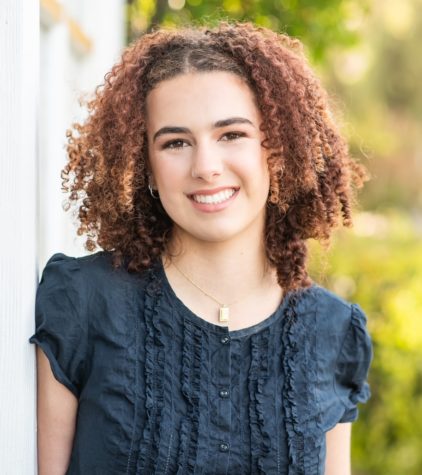
Zoe Lodge is a senior and this is her second year at the Eagle Times! When she isn’t writing (for the Eagle Times, for school, or creatively), you can...







